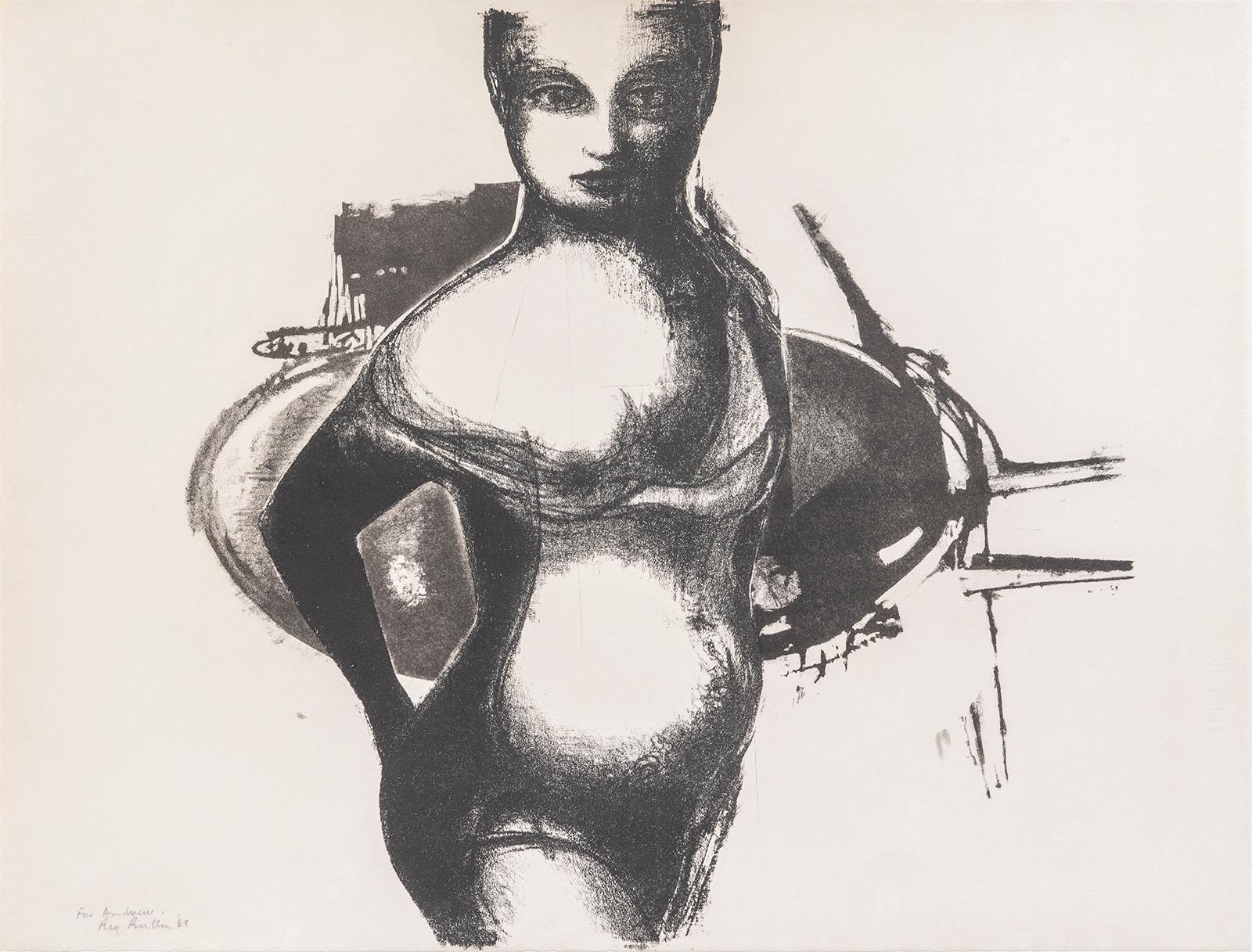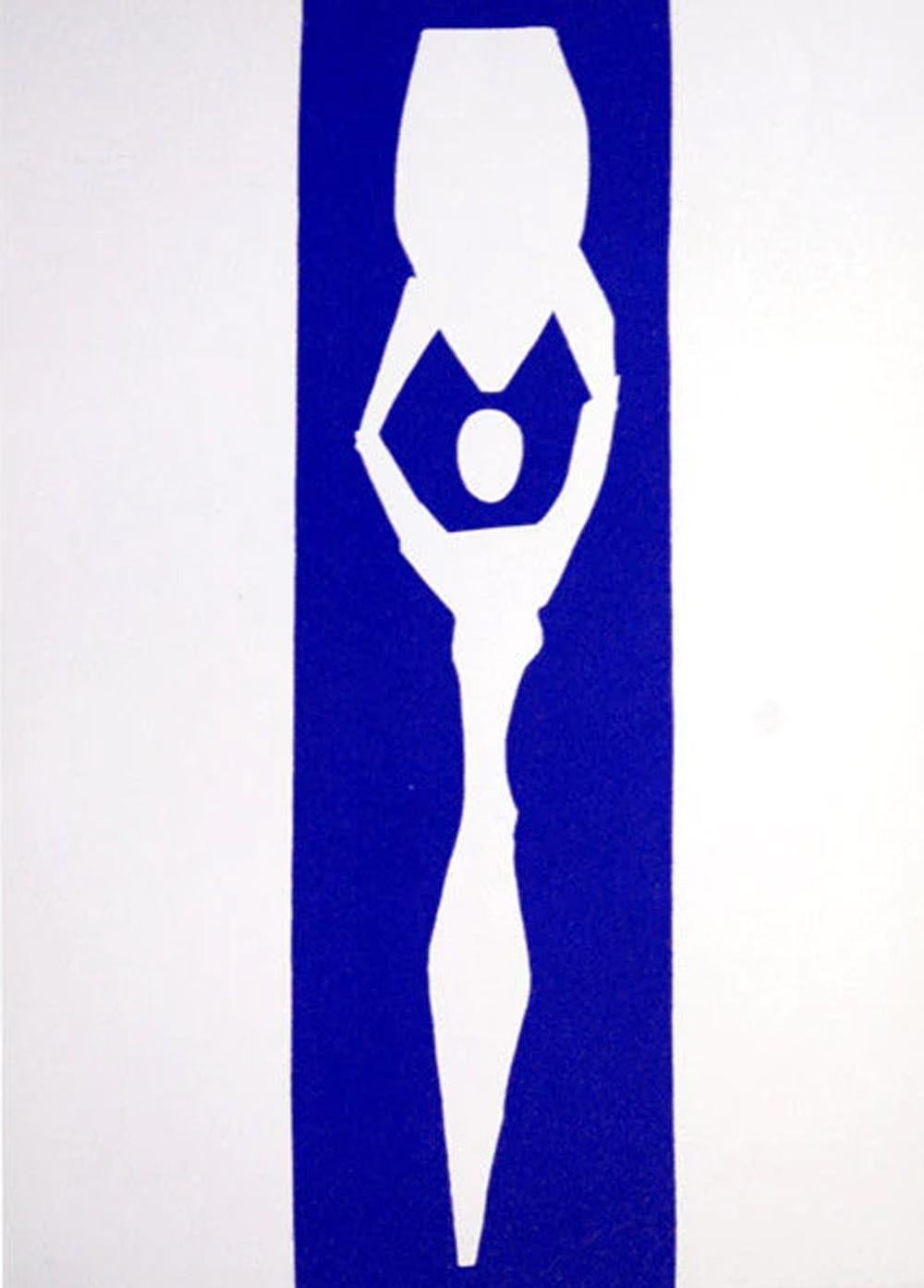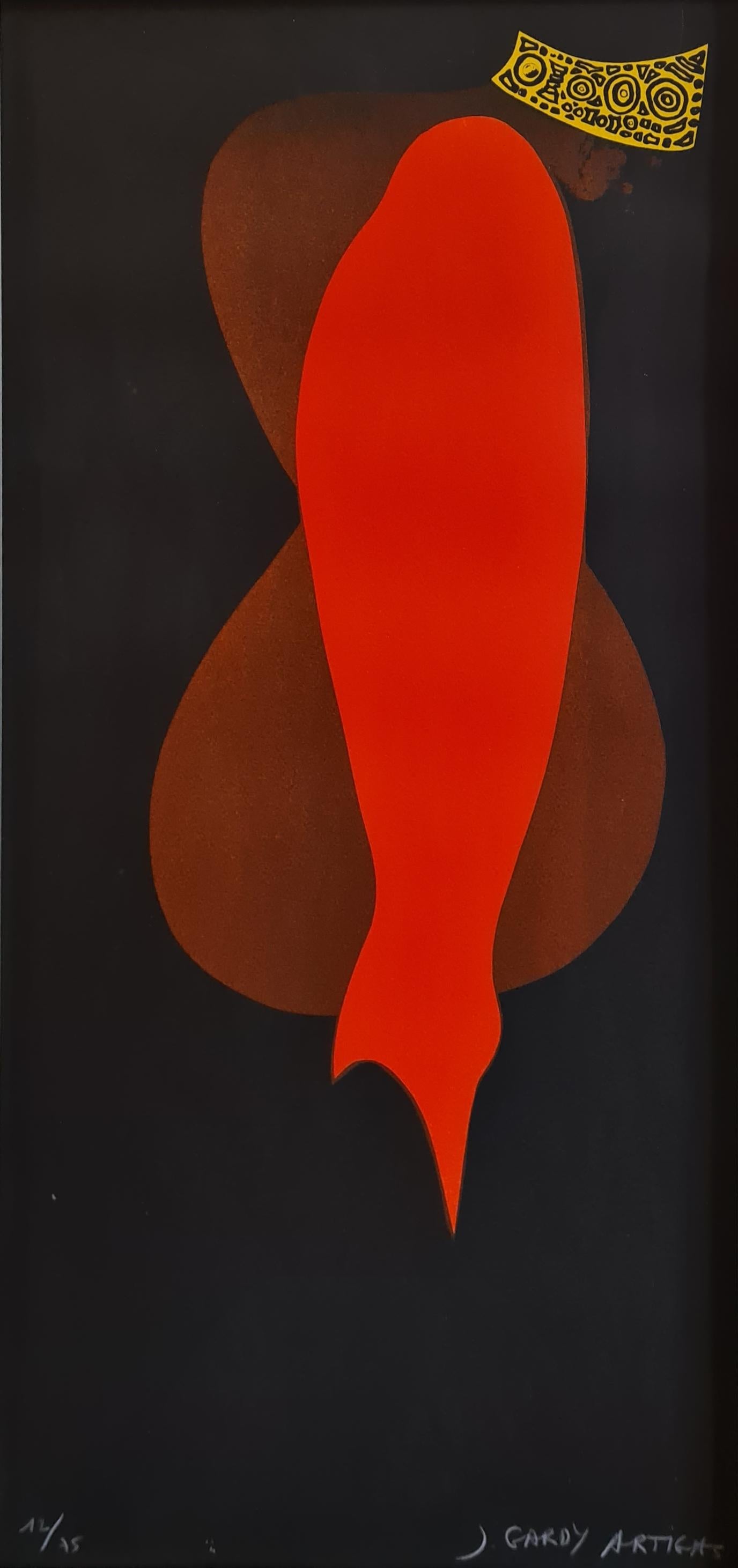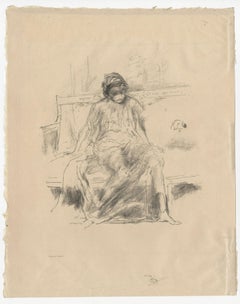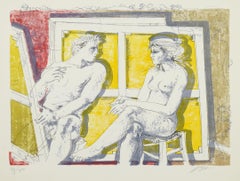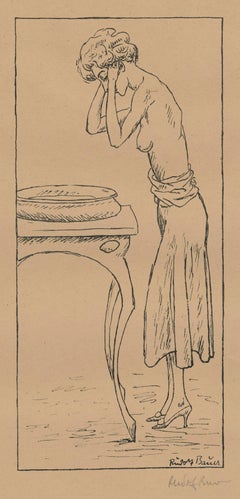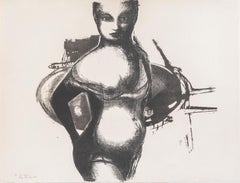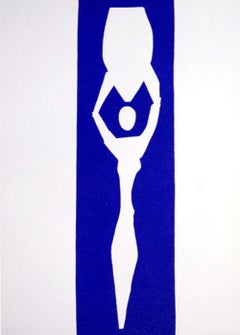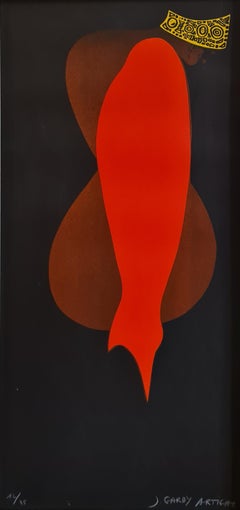Items Similar to Untitled 5 (Woman Resting Against a Chair)
Want more images or videos?
Request additional images or videos from the seller
1 of 12
George SegalUntitled 5 (Woman Resting Against a Chair)1978
1978
About the Item
Untitled 5 (Woman Resting Against a Chair)
Signed and dated in the lower right corner (see photo)
Edition: 100 (43/100 in the lower left corner)
Published by Poligrafa, Spain
Provenance: Martha Jackson Gallery, NY
Anderson Gallery, Buffalo, NY
David Anderson Grandchildren's Trust, Buffalo, NY
David Anderson Gallery and APF Frames labels verso
Image: 29 7/8 x 21 7/8"
Frame: 38 1/8 x 30 1/4"
George Segal
B. 1924, NEW YORK CITY; D. 2000, SOUTH BRUNSWICK, NEW JERSEY
George Segal was born in the Bronx, New York, on November 26, 1924. He studied science at Stuyvesant High School and then spent one year at the Cooper Union, both in New York. While still a student, he worked briefly as a commercial illustrator. After his older brother was drafted into the army in 1940, Segal left New York to work on his father's newly acquired chicken farm in South Brunswick, New Jersey. During this time he took night classes at the nearby Rutgers University, New Brunswick, where he would return much later to earn his MFA in 1963.
In 1946 Segal married Helen Steinberg and soon began commuting to classes at Pratt Institute, Brooklyn, New York. In 1948, inspired by Abstract Expressionist paintings, he transferred to New York University (NYU). Among his teachers were William Baziotes and Tony Smith, and his fellow students included Alfred Leslie and Larry Rivers. After completing his BA in Art Education from NYU in 1949, Segal built and operated his own chicken farm in South Brunswick, New Jersey, for several years with his wife. Allan Kaprow had also been a student at NYU with Segal, but the two did not meet until 1953 when Kaprow was teaching at Rutgers and living close to Segal. Segal's farm became the site for Kaprow's first Happening in 1958, a Robert Frank film in 1960, and over time, the artist's own 6,000-square-foot studio.
Through his relationship to Kaprow, Segal was introduced to the New York avant-garde scene surrounding John Cage and Merce Cunningham, as well as awarded a membership to the Hansa Gallery, where in 1956, for his debut solo show, he exhibited brightly colored, figurative abstract paintings. In 1958 Segal completed his first sculptures using wood two-by-fours, chicken wire, burlap, and plaster, and positioned the three works in front of a series of large canvases. Segal's placement of life-size figures in an environment, a trope for which he became best known, was further developed in July 1961, when he was asked to write about newly developed gauze and plaster Johnson & Johnson bandages as a potential new art material. He was given boxes of the medical material, which he took home and had his wife plaster around him while he sat in a chair. The results led him to continue using different versions of the material to make full-body plaster casts directly from the figures of his family, friends, colleagues, and patrons. These figures were then placed on the ground in relationship to ready-made objects often taken from the urban landscape. While the surfaces of his sculptures were often left white, Segal also occasionally incorporated bright hues into his pieces.
In 1960 Segal began exhibiting with Green Gallery, New York, alongside young contemporary artists such as Donald Judd and Robert Morris. Two years later his work was included in New Realists, an exhibition that helped define Pop art, a movement with which Segal had previously been identified, at the Sidney Janis Gallery, New York. He became a member of that gallery in 1965 and had his first museum solo show at the Museum of Contemporary Art, Chicago (1968).
In 1969, after making pastel drawings of plaster body parts around his studio, Segal began a series of partial figure sculptures and wall reliefs. He produced his first bronze sculpture for an outdoor project in 1976. Other public commissions included memorials to the 1970 Kent State shootings, the Holocaust, and gay liberation. In the 1990s, Segal returned to painting and began a series of photo-sculptures using his own photographs. During the last years of his life, Segal made large charcoal portraits of his friends and family, and participated in a documentary film about his life's work. The film George Segal: American Still Life premiered in 2001, a year after his death in New Jersey. Courtesy Guggenheim
- Creator:George Segal (1924-2000, American)
- Creation Year:1978
- Dimensions:Height: 38.125 in (96.84 cm)Width: 30.25 in (76.84 cm)
- Medium:
- Movement & Style:
- Period:
- Condition:Very good. Floated in matting and framed in welded corner APF under glass.
- Gallery Location:Fairlawn, OH
- Reference Number:Seller: FA95011stDibs: LU14014716282
About the Seller
5.0
Recognized Seller
These prestigious sellers are industry leaders and represent the highest echelon for item quality and design.
Platinum Seller
Premium sellers with a 4.7+ rating and 24-hour response times
Established in 1978
1stDibs seller since 2013
787 sales on 1stDibs
Typical response time: <1 hour
Associations
International Fine Print Dealers Association
- ShippingRetrieving quote...Shipping from: Fairlawn, OH
- Return Policy
Authenticity Guarantee
In the unlikely event there’s an issue with an item’s authenticity, contact us within 1 year for a full refund. DetailsMoney-Back Guarantee
If your item is not as described, is damaged in transit, or does not arrive, contact us within 7 days for a full refund. Details24-Hour Cancellation
You have a 24-hour grace period in which to reconsider your purchase, with no questions asked.Vetted Professional Sellers
Our world-class sellers must adhere to strict standards for service and quality, maintaining the integrity of our listings.Price-Match Guarantee
If you find that a seller listed the same item for a lower price elsewhere, we’ll match it.Trusted Global Delivery
Our best-in-class carrier network provides specialized shipping options worldwide, including custom delivery.More From This Seller
View AllThe Draped Figure, Seated
By James Abbott McNeill Whistler
Located in Fairlawn, OH
The Draped Figure, Seated
Lithograph on fine japanese paper, 1893
Signed in pencil with the butterfly (see photo)
Signed in the stone with the butterfly on the sofa (see photo)
Numbered: "No. 20" in pencil
Printed by Thomas Way, London
A beautiful impression with tonal variations in the stump work (shading)
As published in: L'Estampe Originale, Paris, 1893, Album IV
Edition: 107 impressions, this No. 20
There were an additonal 24 impressions printed by Way for Whistler and 20 impressions printed for the Fine Art Society, London
Lacking the huge support sheet and embossed series stamp by Charpentier
With the letterpress lower left: "T. Way. Imp London"
The stone erased in 1904
The majority of the lifetime impressions are in public collections
Condition: Excellent condition
Hinges from original issuance of L'Estampe Originale verso at top as described in Spink
Three hinges residue along right edge of the sheet from a later matting of the print
Image size: 8 1/4 x 6 3/8 inches
Sheet size: 11 3/8 x 9 1/16 inches
Reference: Spink/Tadeschi 72, published edition
Levy 74
Way 46
A superb Neoclassical lithograph...
Category
1890s American Impressionist Nude Prints
Materials
Lithograph
Le Peintre et Son Modele
By Hans Erni
Located in Fairlawn, OH
Le Peintre et Son Modele
Color lithograph on BFK Rives paper
Numbered and signed in pencil by the artist
Edition 200 (77/200) printed in colors
There is also a black and white editio...
Category
1960s French School Nude Prints
Materials
Lithograph
untitled (Young Woman Washing)
By Rudolf Bauer
Located in Fairlawn, OH
untitled (Young Woman Washing)
Lithograph, c. 1910
Signed in pencil lower right; signed in the plate lower right (see photo)
Image size: 11 x 5-1/8"
Sheet size: 18 7/8 x 12 5/8 inches
Condition: Very good
Aging to the tan paper it is printed on
Provenance: Estate of the Artist
Borghi & Company, NYC
Rudolph Bauer
1889-1953
Rudolf Bauer was born in Lindenwald near Bromberg, Silesia, in 1889 but his family moved only a few years later to Berlin. In 1905 Bauer began his studies at the Berlin Academy of Art but left the Academy only a few months later to educate himself. The upshot was paintings, caricatures and comical drawings which were published in 'Berliner Tageblatt', 'Ulk' and 'Le Figaro'.
From 1912 Bauer contributed to the magazine and Gallery 'Der Sturm' founded by Herwarth Walden and pivotal to German Expressionism and the international avant-garde. In 1915 Rudolf Bauer participated for the first time in a group show at Walden's gallery. There he met Hilla von Rebay, with whom he began a relationship of many years that was crucial to Bauer's later work. By 1922 Bauer had shown work at about eight exhibitions mounted by 'Der Sturm'. From 1918 he also taught at the 'Der Sturm' art school, where Georg Muche was the director. After the war ended, Bauer was a founding member of the 'November Group' although he did not collaborate closely with the group. In 1919 Bauer joined forces with the painter and architect Otto Nebel and with Hilla von Rebay to found the artists' association 'Die Krater'. Impressionist at the outset, Bauer's early work reveals Cubist and Expressionist influences. By 1915/16 Bauer had switched to an abstract pictorial idiom, which is markedly influenced by Kandinsky. In the early 1920s Bauer was also preoccupied with Russian Constructivism as well as the Dutch de Stijl group. Bauer's decided preference for non-representational painting culminated in 1929 with the foundation of a private museum, 'Das Geistreich', which he directed as a salon for abstract art.
Political developments in Germany forced Bauer to sell some of his work in America from 1932. His agent in America was Hilla von Rebay, who was by now director of the Guggenheim Collection. In 1936 she organized a touring exhibition of non-representational European art that included sixty Rudolf Bauer oil...
Category
1910s Jugendstil Nude Prints
Materials
Lithograph
The Draped Figure, Seated
By James Abbott McNeill Whistler
Located in Fairlawn, OH
The Draped Figure, Seated
Lithograph on fine japanese paper, 1893
Signed in pencil with the butterfly (see photo)
Signed in the stone with the butterfly on the sofa (see photo)
Numbe...
Category
1890s American Impressionist Nude Prints
Materials
Lithograph
La Pierre aux Trois Croquis
By Pierre-Auguste Renoir
Located in Fairlawn, OH
La Pierre aux Trois Croquis
From: Douze lithographies originales de Pierre-Auguste Renoir
Publisher: Ambrose Vollard
Edition: 950 (signed in the stone) on wove paper as here (see pho...
Category
Early 1900s Impressionist Prints and Multiples
Materials
Lithograph
Reclining Nude Holding a Necklace
By Albert de Belleroche
Located in Fairlawn, OH
Reclining Nude Holding a Necklace
Lithograph, c. 1908
Signed in pencil lower right (see photo)
Edition: c. 15
Reference: Belleroche No. 525
Condition: Excellent
Image: 16 3/4 x 20"
...
Category
Early 1900s Impressionist Nude Prints
Materials
Lithograph
You May Also Like
Girl
By Reg Butler
Located in Llanbrynmair, GB
’Girl’
By Reginald Butler
Medium - Lithograph
Signed - Yes
Edition - AP
Size - 650mm x 490mm
Date - 1968
Colour of print may not be accurate when viewed on a monitor.
Reginald Cot...
Category
Mid-20th Century Abstract Figurative Prints
Materials
Lithograph
$1,151
Le Jarre I, from 1958 The Last Works of Henri Matisse
By (after) Henri Matisse
Located in Washington, DC
Artist: Henri Matisse (after)
Title: Le Jarre I
Portfolio: The Last Works of Henri Matisse
Medium: Lithograph
Date: 1958
Edition: 2000
Frame Size: 20 1/2" x 15 1/4"
Sheet Size: 14" x...
Category
1950s Abstract Nude Prints
Materials
Lithograph
'Chamonix' Mid-Century Hand Signed Original Lithograph.
By Joan Gardy Artigas
Located in Cotignac, FR
Mid-Century original lithograph entitled " Chamonix " hand signed by Joan Gardy Artigas and numbered 12/75 on arches vellum rag paper from the 1966-70 edition. Presented in period 19...
Category
Mid-20th Century Abstract Figurative Prints
Materials
Printer's Ink, Rag Paper, Lithograph
Les Poetes, La Poesie, Front Page
By Henry Moore
Located in San Francisco, CA
Artist: Henry Moore (British, 1898-1986)
Title: Les Poetes, La Poesie, Front Page
Year: 1976
Medium: Color lithograph
Edition: 110
Paper: Arches
Paper...
Category
1970s Abstract Abstract Prints
Materials
Lithograph
Dame Creole
By Henry Moore
Located in San Francisco, CA
Artist: Henry Moore (British, 1898-1986)
Title: Dame Creole
Year: 1976
Medium: Color lithograph
Edition: 110
Paper: Arches
Image size: 18.5 x 15 inches
paper size: 18.5 x 15 i...
Category
1970s Abstract Abstract Prints
Materials
Lithograph
Les Poetes, La Poesie
By Henry Moore
Located in San Francisco, CA
Artist: Henry Moore (British, 1898-1986)
Title: Les Poetes, La Poesie
Year: 1976
Medium: Color lithograph
Edition: 110
Paper: Arches
Paper size: 18...
Category
1970s Abstract Abstract Prints
Materials
Lithograph
Recently Viewed
View AllMore Ways To Browse
Large Bronze Woman
Bronze Nude Woman
Sculpture Plaster 1940
Spanish Wood Framed Chairs
Plaster Cast Figure
Chicken Sculptures
Series 7 Vintage Chair
1970 Outdoor Chairs
Plaster Relief Wall Sculpture
Large Plaster Relief
Farm Chair Wood
Outdoor Corner Chair
George 5 Chairs
Cage Chair
Robert Wood Cast
Used Drafting Chair
Used Drafting Chairs
Sator Square
